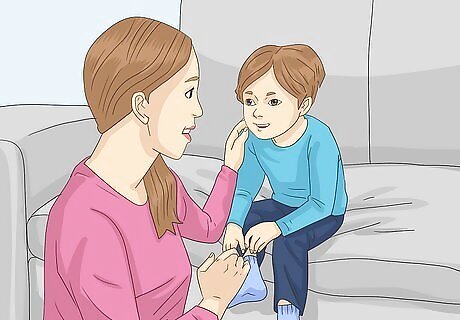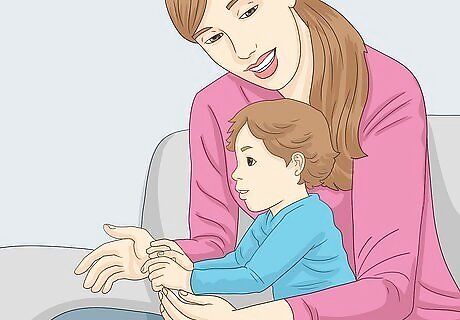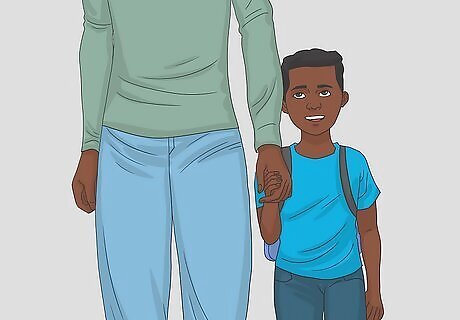
views
Adjusting Your Daily Routine

Set up some practice days. If your child has never been away from home for more than a few hours, it can be helpful to have a few practice days. Talk to your daycare center about dropping your kid off for a couple of hours on a trial basis. If your center does allow trial admissions or if you want to gradually build up the time you are apart, ask a family member or close friend to watch your child in their house for the day. These can acclimate both of you to the idea of spending a half or full day apart.

Create a morning routine for you and your child. Start developing your new morning routine during your practice days so that it’s in place on the big day. You need to be able to get your child ready and out the door in plenty of time to take them to the daycare. If your child is old enough, talk to them about the schedule in advance and be as details as you can. That way they know exactly what to expect. For example, you may decide that your morning routine is wake up, shower, wake up your kid, make breakfast, get them cleaned and dressed, then head out the door. Let your child know about these plans to help them prepare. The exact nature of your routine will depend on what you and your kid like to do in the morning. As long as you keep it consistent, you will both know what to expect when their first day comes.

Have an open discussion with your child about daycare. Some parents get worried that their children will resent them for sending them to daycare. Talk to your child openly and honestly about what daycare is and why they are going. Explain daycare as a fun place where they can play, learn, and make friends. This can help them understand and contextualize a major change in their life. For example, you could let your child know, "Today, you are going to spend some time making new friends. I will be gone for a few hours, but a nice lady named Ms. Carol will help take care of you. If you need anything, let her know. I'll come back at 12:30 to pick you up." To help your child feel less nervous, send something like a favorite toy or blanket from home. Tell them, “I’ll be back in a few hours, but while I’m gone Mr. Bear will be here to remind you of home, and Ms. Carol will be here to help take care of you.”
Navigating the First Day

Plan to spend some time getting your child settled. Plan to arrive a little early so that you can help your kid get settled into the classroom. In some centers, the caregivers may have you stick around for the first hour or two so that your kid can adjust to the new environment with you there. If you’re unsure about what first-day protocol will be, call the daycare in advance and ask them how long you should anticipate being there to help your child adjust.

Help your child with any separation anxiety they may have. Some children have a very tough time coping with being away from their parents. It can be heartbreaking to walk away from your child when they are crying and clinging to you. If this is happening, take a moment to tell them when you will be back and what you will be doing while you are gone. Then, say goodbye and calmly leave. The staff should be trained in helping both you and your child through this challenge. It may seem challenging or invasive at first, but let them help if they offer. Sometimes, they have one of the staff members stay with your child until they are calm and ready to play and participate in the group activities. They might also set up a play buddy for your child so that they don’t feel alone.

Say a loving but short goodbye. When it does come time for you to leave, let your child know that you love them, that you will be back in a few hours, and that they should have fun at daycare. Keep the goodbye sweet but short. A long goodbye could make your child worry because you are reassuring them too much, while sneaking out can be traumatic. Try to make your goodbyes a routine. Go through the same doors, hang up their coat, go through their cubby, check any materials the caregivers may have, and say your goodbye. This will set the stage for what your child expects every day when they return. Even if your child isn’t old enough to understand your words during a goodbye, start the routine. This will make it easier for them as they grow.

Arrive on time for pick up. Make time your first day to arrive at your scheduled pickup time. If you can, arrange your schedule so that you have a consistent pickup time for the week. As your child adjusts, it can be comforting for them to know that they are going home at a certain point or after a certain activity like afternoon naps. Try to make pick up as much of a routine as drop off. There may be days when your child is sick where you need to come get them early, and there may be times when work or other obligations make you a little late. As much as possible, though, keep pick up consistent. Designate an emergency contact, such as your partner or your child’s grandparents, who are approved to come pick up your kid if you are unable to make it for any reason.

Make extra time to bond when you get home. Once you and your child get home, take some extra time to talk to them about their day, play with them, or just spend some time together. This lets your child know that they still matter to you even when you’re not there for part of the day. If you have something you can’t avoid immediately after pick your child up, try to build in something special for them. If you need to get to the bank, for example, let your kid know you have to run an errand, but offer to get ice cream on the way home, too.
Coping with Your Emotions

Allow yourself to feel sad. Just don't show these feelings around your child, as it might be confusing for them. No matter how much you plan, you can’t fight your emotions. The first time you drop your child off, you may even cry. Let yourself feel sad for the first couple of days. The more you go through the process, the easier it will become. Don't let your child see you crying, as they interpret crying in simple ways. They may think that you are hurt. They may draw the conclusion that daycare is hurting you or that it's a dangerous place. Alternatively, they may think that they are hurting you. Unless your child understands the concept of "happy tears," hold in your emotions until you're away from your child.

Treat yourself after first day drop off. Dropping your kid off at daycare is not only emotional for your kid, it's often hard for the parent, too. If you have work, consider taking the day off so that you can emotionally adjust. Try to distract yourself with a treat like going to see a new movie, getting a pedicure, or working on a project you rarely have time for. You are going to feel sad, and that's ok. Distracting yourself can help prevent you from spending all day worrying or wallowing, though.

Focus on the big picture. If you are feeling sad or guilty about sending your child to daycare, think about the big picture. Daycare lets you have the time you need to work or manage your day. Not only that, but daycare allows your child to socialize, start their early education, and build skills that they will use for the rest of their life. Sometimes it is hard to see the bigger picture, but repeating an affirmation may help. Try saying, “My child must go to daycare so that I can do ___ to provide him/her with a better future,” or “daycare can help my child learn and grow in important ways.”
Choosing the Right Daycare

Pick the type of daycare you want for your child. Daycares can be broadly broken down into group daycare and home daycare centers. Group daycare centers are licensed facilities that run like a school. Home daycare is typically run out of a provider’s home and may or may not receive the same licensing and training. Decide which type is more appropriate for your child to make sure you are searching the right kind of facilities. Typically, group daycares have a more educational curriculum, always have more than one caregiver present, are more closely regulated and monitored, and have caregivers with an early childhood education background. Home daycares are often closer to a nanny or babysitter. Your child may receive more one-on-one attention depending on the caregiver’s personal limit, and curriculum may be more informal.

Start looking for a daycare at least 6 months in advance. If you know ahead of time that you will be sending your child to daycare, start looking at locations at least 6 months before the planned start date. If you live in a city where spots fill up fast or only want to consider elite schools, you may need to start looking even earlier. Not only does this give you time to find a slot, it will give both you and your child some extra time to adjust to the change in routine.

Evaluate the daycare centers to check for signs of quality. Choosing a daycare is important because both you and your child need to feel comfortable with the facilities and caregivers. The first thing to look for is a daycare’s reputation. Check with other parents of children at the daycare and read online reviews. A good daycare should be known for being friendly and nurturing. You should also look for a daycare that: Has an established, written set of policies regarding its operations, emergency procedures, and sick children. Has a current license and credentials on file with your local social services department. Has safe facilities with clean floors, walls, and kitchen and prep areas, as well as ample room inside and outside for all the children in care there to move, explore, and feel comfortable. Has a well-trained staff. Provides age-appropriate and developmentally appropriate activities. Has appropriate disciplinary procedures that are consistent with your own. Has a system in place to notify you about your child's progress or behavior.

Look for a daycare that has a set schedule. Choosing a daycare that follows a daily schedule makes the transition easier because both you and your child will know what to expect. Look for a daycare with a diverse curriculum that includes physical activity, naps, daily reading sessions, group programs, individual activities, meals, snacks, and some free time. A well-thought-out curriculum is both fun and educational for your child. If you have additional educational requirements, such as a bilingual staff, look for that in the curriculum.

Take the time to meet the staff in-person. The staff should be caring and nurturing toward your child and treat the parents with respect. Additionally, qualified staff should have at least an associate’s degree in early childhood education, as well as CPR and other emergency care training. Schedule a visit to meet the staff and see if you like them. States and provinces may have their own, specific requirements for daycare workers. Be sure to check your local regulations to make sure the daycare staff meets local regulations. Think of your visit like you are interviewing the daycare for a job. Ask questions about everything including hours, fees, child-to-caregiver ratios, teaching and discipline philosophies, food nutrition, and anything else you may need to know.


















Comments
0 comment